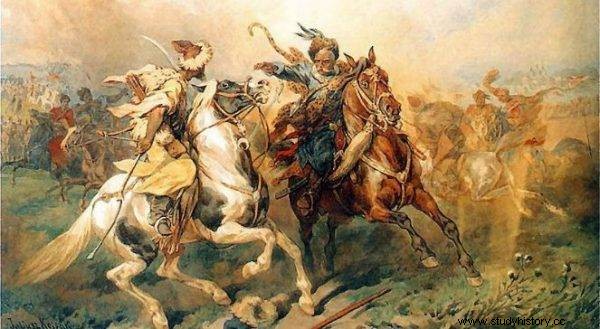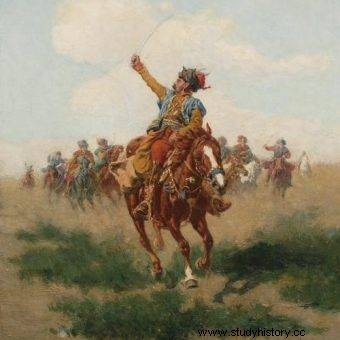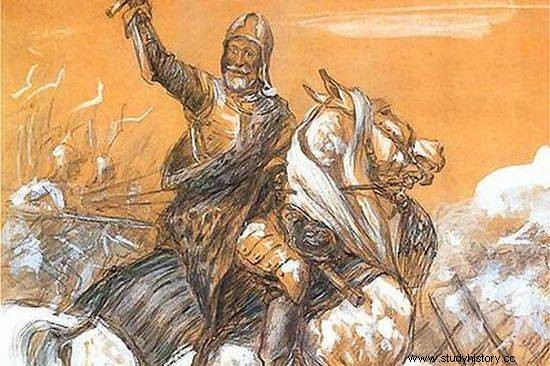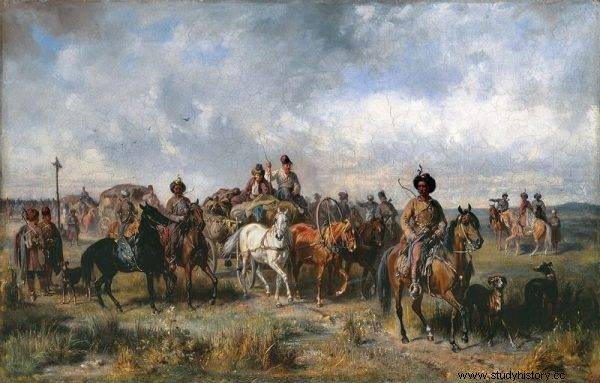Their element was war. Parades and battles, but above all attacks on enemy cities and villages. They provided what the foxes wanted most - loot! They left only the ruins of burnt huts, crying, fear and hatred.
One clear night, somewhere in the Russian steppe, the sleep of the inhabitants of the chutor was interrupted by the rumbling of hooves on the dry earth and the glow of burning torches. Before anyone understood what was going on, a squad of riders burst into the narrow street, between the rows of cottages. The rumor grew larger, the shouts, threats and sobbing of women filled this hitherto peaceful area. The chaos of the slaughter woke more and more inhabitants from sleep, who were dying with horror from the blows of Polish sabers; finally the thatch flared with a colored flame illuminating the bloody games ...
In the morning, when the first rays of the sun came out from behind the horizon, the dark ruins of the burning houses remained from the chutor. The corpses of men, women and children lay on the beaten road. Somewhere a dog whined, somewhere black birds called to feed with croaks ... Those who managed to survive left the area, and with them was the fear of the Lisowczyk family.
Lisowczyki - Tatar military school
When the modest nobleman Aleksander Lisowski in 1607 knocked for the first time at Dmitri's quarters, no one could have imagined that the self-proclaimed tsar was facing a man whose mothers would frighten Russian children a hundred years after the Russian civil war.

Aleksander Lisowski, according to many historians, perfected the Tatars' school of warfare in the 17th century. The illustration shows Juliusz Kossak's painting "Tatar Dance" (source:public domain).
The career of Aleksander Józef Lisowski began a good few years earlier. Already at the end of the 16th century, along with other Poles, he entered the service of the Moldavian hospodar, Michał the Brave. There, he first met the Tatar school of warfare and learned the rules of guerrilla warfare and the fast and unexpected patches on the enemy's lands, appreciated by the Tatars. What he learned at Multanach was to be of use to him in the future. For Lisowski quickly grasped the Tatar school of warfare and, according to some historians, he perfected it.
Fox legacy
On the reputation of the terror of Russian children, the Lisowowcy worked diligently. On the threshold of his stay in Russia, on the orders of Dmitri, he gathered a unit of the Don Cossacks and began the bloody harvest with them. Success followed suit. He defeated Tsar Wasyl Szujski's troops, commanded by Chowanieński and Lapunov, and even conquered Kolomna. 
Happiness left Zagończyk and his thugs only in the battle of Niedźwiedzi Bród in 1608. The beaten but not dispersed light cavalry unit retreated to Tuszyn, where Dimitri was standing. Szalbierz (as Dymitr was called) praised Lisowski and gave him a new task. This time, together with Jan Sapieha, Jan Sapieha, the alumnus, he was to take over the Troicko-Sergiejewski monastery.
Lisowski and Sapieha eagerly embarked on the new task, hoping for a quick and spectacular success. Meanwhile, the siege dragged on and did not bring the expected results. Sapieha shelled it, stormed the monastery, and Lisowski, who had been chased by the fortress, roamed the land of Suzdal and Włodzimierz, looting and burning. He even made his way to the Volga region, he reached Jarosław along the way, capturing Kostroma and Galicz.
The next months of service passed, the foxes crumbled, and their place was taken by new ones, tempted by gold and fame. However, the year 1609 came, and the Polish Republic and King Sigismund III officially joined the war with Russia, which had been a private row of magnates so far. Poles thanked Dymitr for his service and returned to the country. Aleksander Lisowski went with them.
At that time, he settled in the Zawołocki castle on the very Russian border. However, he did not stop his military trips. He organized them further, looting and burning the border areas. He spent two years in this rogue practice. In 1611, the Seym banished Lisowski and appointed him to the royal service.
Hetman Jan Karol Chodkiewicz accepted him under his sign, noting, however, that he was serving for free, but was allowed to plunder the enemy's country. This suited Lisowski's light cavalry commander. He got used to such service, in which it was easier to get a penny than on the Polish wages.
Lisowowcy - His Majesty's robbers
Weeks of hard recruitment work have now begun for Aleksander Józef Lisowski. He was looking for brave but also rebellious people, ready at any moment to sacrifice, but lootable and ruthless - in a word, the gangsters like the Kmita company. In the vast Polish Republic under the rule of Sigismund III Vasa, he found many such. He encouraged skirmishers he recruited to serve with the following words:
Your weapons will be a saber and a harness, a bow with a sajdak, rohatyn, a light and persistent horse, I will not suffer from carts, tobogs, or fagots; you will carry everything with you. ... [...] To run the most distant enemy routes, burn lands, destroy villages, cities, drive thousands of cattle and prisoners ahead of you, let no one pass, this is your only job from now on.
The campaign of 1614 showed how much were worth the Lisowski. Lisowski did not spare his killers, on the contrary, he immediately threw them into deep water. Together with Andrzej Sapieha, he set off to the besieged by Russians Smolensk. Quietly avoiding the guards, he crept through the enemy lines.

After he was banished from Lisowski in 1611, he was ordered by Jan Karol Chodkiewicz. On the lustration, hetman Chodkiewicz by Juliusz Kossak (source:public domain).
Where he had to, he was digging up ramparts, destroying cannons and cutting down the Russians. This is how he got to the fortress, bringing with him supplies of food and weapons. If Lisowski's people counted on rest in the city, they were wrong. The idyll ended quickly as they were ordered to go deep into Russia.
Lucky streak is over
Despite the fact that the Lisowski traveled 100-150 km during the day, escaping the enemy or attacking him unexpectedly, the expedition was only half-successful. Yes, Lisowski absorbed the attention of Russian troops and destroyed enemy territory with fire and sword, but he himself succumbed to the army led by Prince Pozharsky. Once he even got surprised by a Russian driveway.
Whether it was because of overconfidence or neglect, he did not put up a watch. At night, the Russians attacked the sleeping foxes. Here, however, Lisowski showed talent. He managed to control panic, assemble a squad and beat the enemy. Despite his setbacks, he was appointed a colonel of His Majesty.

The Lisów people showed their value in 1614, when they provided supplies for the crew of the besieged Smolensk. The illustration shows the painting by Józef Brandt "The Lisowczyk Parade" (source:public domain).
In January of the following year, he received an order from Chodkiewicz to assemble a new branch. This time, only six hundred men were enlisted. Nevertheless, Lisowski set off for Russia on well-known routes. Human groans and the smoke of burning houses followed in his footsteps. During the expedition of 1615, he reportedly reached the shores of the White Sea. It was his last trip. In 1616 he died, and the death of Lisowski is accompanied by a mystery. It is not known whether he was poisoned or murdered. The Lisowski returned to the country and stayed there throughout 1617 and 1618, plundering the Commonwealth like hostile land ...
Also be sure to read about the Polish secret of Rembrandt's famous painting "Lisowczyk"!
Sources:
-
- W. Dembołęcki, Diaries about the Lissowczyk family, or the Advantages of the Polish Elars (1619-1623) , Krakow 1859.
- M. Dzieduszycki, A Brief History of the Lisowczyk Family , Lviv 1843.
- H. Wisner, Lisowowcy, Warsaw 2004.
- W. Pole, For the Kremlin and the Smolensk region , Toruń 1995.
